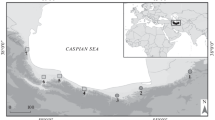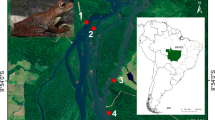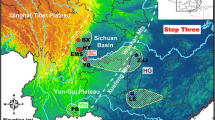Abstract
Background
Fejevarya limnocharis (Dicroglossidae) is found widespread in Peninsular Malaysia. We analyzed the mitochondrial DNA control region sequence data to evaluate the genetic variability and population structure of this species, based on 106 individuals from 14 populations in the west coast (northwest and central west) and two populations from the east coast of Peninsular Malaysia.
Results
Of 519, 13 variable sites (six parsimony informative sites) were observed, defining 14 unique haplotypes. We found very low levels of genetic variability, with three of the 16 populations exhibiting total absence of genetic variation. Both phylogenetic analyses based on NJ and MP methods failed to detect any geographic structuring between the east and west coast (northwest and central west combined) populations.
Conclusions
Consequently, it can be inferred that genetic structuring F. limnocharis populations in the Peninsular Malaysia was largely shaped by natural barriers. However, when this breaks down as between the central west and east peninsular regions, genetic differentiation is reduced. Further studies, with more efficient markers and larger populations, especially from the southern regions, are required to corroborate the findings.
Similar content being viewed by others
Background
The Asian Grass Frog, Fejevarya limnocharis, is a common and widespread amphibian in South Asia and Southeast Asia. Its distribution covers a number of islands in Indonesia, the Philippines, Phuket, and Singapore and is also found as far as the northern, central, southern, and southwestern China (including Taiwan, Hong Kong, and Macau), western Japan, western half of Honshu, Shikoku and Kyushu Districts, and Nansei Islands. Recently, this species was introduced into Tsushima and Iki (van Dijk et al. [2009]). It has also been observed throughout a wide range of altitudes (2 to 2,000 m) in China (Fei and Ye, [2001]). In Malaysia, the species is ubiquitous in disturbed habitats associated with human activities including paddy fields, roadsides, lawns, agricultural fields, football fields, and lowland forests (Inger and Stuebing, [1997]; Ibrahim, [2004]; Norhayati et al. [2009]). Being widely distributed, F. limnocharis is an ideal subject for population genetics and phylogeographic investigations and the mechanisms or forces most likely to have been involved in shaping their population pattern.
Maternally inherited mitochondrial DNA is an efficient genetic marker in genetic-differentiation studies, due to its higher mutation rate of base substitution compared to nuclear DNA (Qiongying et al. [2006]). The control region or displacement loop (D-loop) gene is the only noncoding segment in vertebrate mtDNA (Faber and Stepien, [1998]) and encompasses the sites of initiation for H-strand replication and both H- and L-strand transcription (Sumida et al. [2000]). The D-loop segment evolves much faster than the average mitochondrial gene (Brown, [1985]), although it also has short sequence elements conserved among most vertebrates studied (Wolstenholme, [1992]). Because of its ability for rapid change, the D-loop region is an ideal choice for addressing population-level genetic questions (Hoelzel et al. [1991]).
The genetic variation of amphibians in Malaysia using mtDNA sequencing methods have been reported by Ramlah ([2009]) and Ramlah et al. ([2010]). Their studies mainly involved amphibian populations from Malaysian Borneo (Sabah and Sarawak) with limited samples from Peninsular Malaysia. However, they have provided a foundation for further studies in addressing population subdivision of the Malaysian amphibians. The objective herein was to determine the genetic variation in F. limnocharis populations from 16 different populations throughout Peninsular Malaysia, through DNA sequencing of D-loop of mtDNA.
Methods
Sampling location and collection
A total of 106 individuals of F. limnocharis representing 16 populations throughout Peninsular Malaysia were sampled during the period of 2010 to 2011. These populations were provisionally divided into three regions; northwest, central west, and east (Table 1). The northwest was defined as the region in west Peninsular Malaysia restricted by the Titiwangsa mountain range in the east and Bintang mountain range in the south. Populations to the south of the Bintang mountain range and west of the southernmost tip of the Titiwangsa mountain range were categorized as central west Peninsular, whereas those east of the Titiwangsa mountain range were classified as east Peninsular (Figure 1) (Tan et al. [2012]). Freshly captured specimens were immediately identified by referring to Berry ([1975]) and Norhayati et al. ([2009]). All specimens were injected with benzocaine solution into its dorsal lymph sacs to humanely kill them before dissection. Each liver tissue (approximately 10 mg) was preserved in 95% ethanol and stored at room temperature (approximately 25°C) until use. This study has been approved by the USM Ethics Committee. All practical steps to ameliorate suffering by specimens were taken throughout this study. Voucher specimens were then deposited at the Herpetological Collections, Universiti Sains Malaysia for future reference.
Sampling localities of Fejevarya limnocharis and simplified map defining regions involved in the study. (a) Sampling localities of the 16 Fejevarya limnocharis populations analyzed in the study. Closed circles (followed by numbers) represent the sampling sites. (1) Pulau Langkawi, (2) Jitra, (3) Lembah Bujang, (4) Sedim, (5) Ulu Paip, (6) Sungai Burung, (7) Sungai Acheh, (8) Bukit Panchor, (9) Kuala Kangsar, (10) Pusing, (11) Langkap (northwest), (12) Sabak Bernam, (13) Tanjong Karang, (14) Kepong, (central west), (15) Kubang Kerian, (16) Besut (east). (b) Simplified map defining regions involved in this study. NW = northwest, CW = central west, E = east.
Molecular analysis
DNA extraction was with a DNeasy Tissue Kit (QIAGEN, Venlo, Limburg, Netherlands) according to manufacturer’s instructions. A segment of the D-loop mtDNA gene was amplified using a pair of primers - forward primer 327-L (5′-CTG TCC ATA TCA TGA CTA CTT G-3′) and reverse primer 885-H (5′-GGT CTT AGC TTG TAG AGA GGT C-3′) (Zhong et al. [2008]). PCR was done in a Peltier thermal cycler (MJ Research Waltham, MA, USA), with the following profile: pre-denaturation at 94°C for 1 min, 30 cycles of denaturation at 94°C, annealing at 50°C, and extension at 70°C for 1 min each, followed by final extension at 72°C for 5 min. The PCR products were then purified using Wizard® SV Gel and a PCR Clean-Up System by Promega (Promega Madison, WI, USA) and sequenced on an ABI3730XL Genetic Analyzer (Applied Biosystems, Foster City, CA, USA).
Data analysis
Sequences were edited using MEGA 6.0 (Tamura et al., [2013]) and aligned with Clustal W 1.6, implemented in the same software. The aligned sequences were then referenced to the Basic Local Alignment Search Tool (BLAST; http://www.ncbi.nlm.nih.gov/blast) to confirm the identity of the samples, where possible. The aligned sequences were then exported to Collapse version 1.2 (Vigo, Spain) (Posada [2004]) to compute the haplotype datasheet. Haplotype sequences were then generated using DNA Sequences Polymorphism (DnaSP) program version 5.10.01 (Librado and Rozas, [2009]). Arlequin version 3.0 (Excoffier et al. [2005]) was used for calculating nucleotide and haplotype diversities and FST values. Bonferroni correction was applied, with global significance level at 0.05 to correct for multiple comparisons. A bootstrap (10,000 replicates) neighbor-joining (NJ) and maximum parsimony (MP) tree was constructed based on the Kimura-2-parameter model (Kimura [1980]) to depict haplotype relationships using the MEGA 6.0 software. A minimum-spanning network (MSN) connecting all haplotypes was generated using Network (Bandelt et al. [1999]) program to illustrate this relationship.
Results
Final aligned sequences of 519 bp in the mtDNA D-loop gene were obtained. Fourteen unique haplotypes were identified from the 16 populations of 106 individuals. The sequences have been submitted to the GenBank (accession numbers KF051071 to KF051084). Low within population nucleotide diversity, π (0.000 to 0.006) was observed in all populations while haplotype diversity, h, was in the range of very low to moderate in each locality (h = 0.000 to 0.833). Number of haplotypes and polymorphic sites per population ranged from 1 to 8 (Table 2). Trend of low intrapopulation variability was also supported by the genetic distances observed based on Kimura-2 parameter (Table 3).
The minimum spanning network relationships among all the haplotypes are presented in Figure 2. The two common haplotypes, namely Haplotype 1 and Haplotype 5, were observed in almost equal frequency (35% and 38%, respectively). Haplotype 1 was common to all three regions although was missing in one population each in central west and east (Kepong and Kubang Kerian) while Haplotype 5 was observed in all central west and the eastern regions except a few populations namely from Sedim, Pusing, Langkap, and Kuala Kangsar (northwest). Eleven of the 14 haplotypes (except 1, 3, and 5) were unique to either the western or eastern regions.
Minimum spanning network showing relationships among 14 haplotypes of mtDNA D-loop gene of F. limnocharis . Minimum spanning network showing relationships among 14 haplotypes of mtDNA D-loop gene of F. limnocharis, classified according to regions. The nucleotide mutation sites joining two haplotypes are showed in numbers. The size of each circle is an approximate indication of haplotype frequency [black circle found in northern region populations; dark gray circle found in northwest region populations; light gray circle found in east populations; open circle is the intermediate (mv)].
Low genetic differentiation among populations in the northwest region was indicated by the low pairwise FST (Table 3) values. Populations from central west and eastern regions were highly differentiated from the northwest populations with the exception of Sabak Bernam (central west), which showed low genetic differentiation with the northwest population. This was strongly supported by the NJ (data not shown) and MP phylogenetic trees, which divided the haplotypes into two major groups with high bootstrap values (100%) (Figure 3).
Maximum parsimony tree based on the Kimura-2-parameter distance model. Maximum parsimony tree based on the Kimura-2-parameter distance model showing the control region haplotype relationships among 16 populations of Fejevarya limnocharis. The numbers on branches indicate the bootstrap values based on 10, 000 replications.
Discussion
The present study has provided initial insights into the genetic distribution of F. limnocharis in Peninsular Malaysia. In general, mean nucleotide and haplotype diversities were low over all samples (π = 0.004 ± 0.00005; h = 0.471 ± 0.27). Grant and Bowen ([1998]) hypothesized that populations with low values of both parameters (π ≤ 0.5%, ɦ < 0.5) is a feature of recent population bottleneck or founder event by a single or a few mtDNA lineages. Farjallah et al. ([2012]), through Cytb gene analysis, reported that low levels of both nucleotide and haplotype diversities (π = 0.002; ɦ = 0.7) in the North African Green Frog Pelophylax saharicus in Tunisia may be due to a recent population expansion from a small founder population. Nevertheless, as a consequence of marker characteristics, an underestimation of the true levels of genetic variability is possible. Hence, other markers for population studies, such as microsatellites, should also be investigated.
Regional genetic differentiation among F. limnocharis populations were relatively high between the northwest with central west (excluding Sabak Bernam population) populations and each pairwise population comparison between the two regions showed significant genetic differentiation, the Bintang range being an effective divider between the two regions. However, remarkably high intra-regional gene flow was observed within the northwest region, perhaps a result of connectivity between populations of this region.
In contrast, the central west and east coast region showed unexpected genetic homogeneity. Some frog species use roads as activity corridors, including the Cane Toad, Bufo marinus (Seabrook and Dettmann, [1996]), and Natterjack Toad, Bufo calamita (Stevens et al. [2006]). Fejevarya limnocharis is generally abundant in human habitation and this may increase the opportunity for the frog to be transported accidentally or deliberately into new areas (Toda et al. [1997]). Thus, it seems plausible that migration had occurred between the central west and east coast of Peninsular Malaysia via the East-West Highway and colonized new populations, thus reducing their genetic differentiation. This is in tandem with the high capability of dispersal possessed by this species.
It is not possible to compare the pattern of population structuring with other Malaysian amphibians as to date only limited molecular data (Ramlah et al. [2010]) is available on the amphibians in Peninsular Malaysia. More intensive sampling on the investigated sites or sampling of increased number of sites particularly in the east coast and southern regions could confirm this.
Conclusions
Based on this preliminary analysis, it can be inferred that the genetic structuring of the Peninsular Malaysia F. limnocharis population was largely shaped by natural barriers. However, when this breaks down as between the central west and east Peninsular regions, genetic differentiation is reduced. Further studies, with more efficient markers and larger populations, especially from the southern regions, are required to corroborate the findings.
References
Bandelt HJ, Forster P, Röhl A: Median-joining networks for inferring intraspecific phylogenies. Mol Biol Evol 1999, 16: 37–48. 10.1093/oxfordjournals.molbev.a026036
Berry PY: The amphibian fauna of Peninsular Malaysia. Tropical Press, Kuala Lumpur; 1975.
Brown WM (1985) The mitochondrial genome of animals. Mol Evol Genet 95
Excoffier L, Laval G, Schneider S: Arlequin ver. 3.0: an integrated software package for population genetics data analysis. Evol Bioinform Online 2005, 2: 47–50.
Faber JE, Stepien CA: Tandemly repeated sequences in the mitochondrial DNA control region and phylogeography of the Pike-perches Stizostedion . Mol Phylogenet Evol 1998,10(3):310–322. 10.1006/mpev.1998.0530
Farjallah S, Amor N, Merella P, Said K: Pattern of genetic diversity of North African green frog Pelophylax saharicus (amphibia) in Tunisia. Pak J Bio Sci 2012,44(4):901–907.
Fei L, Ye CY: The colour handbook of amphibians of Sichuan. China Forestry Publishing House, Beijing; 2001.
Grant WAS, Bowen BW: Shallow population histories in deep evolutionary lineages of marine fishes: insights from sardines and anchovies and lessons for conservation. J Hered 1998,89(5):415–426. 10.1093/jhered/89.5.415
Hoelzel AR, Hancock JM, Dover GA: Evolution of the cetacean mitochondrial D-loop region. Mol Biol Evol 1991,8(4):475–493.
Ibrahim J: Aspects of biology and ecology of two sympatric frog species in Malaysia. Yusran Publishing House, Sungai Petani; 2004.
Inger RF, Stuebing RB: A field guide to the frogs of Borneo. Natural History Publications, Kota Kinabalu; 1997.
Kimura M: A simple method for estimating evolutionary rates of base substitutions through comparative studies of nucleotide sequences. J Mol Evol 1980,16(2):111–120. 10.1007/BF01731581
Librado P, Rozas J: DnaSP v5: a software for comprehensive analysis of DNA polymorphism data. Bioinformatics 2009,25(11):1451–1452. 10.1093/bioinformatics/btp187
Norhayati A, Belabut DM, Chan KO (2009) Amphibians and reptiles of Peninsular Malaysia. http://amphibia.my/index.php. http://amphibia.my/index.php Accessed 22 December 2009
Posada D: Collapse: describing haplotypes from sequence alignments. University of Vigo, Spain; 2004.
Qiongying T, Huanzhang L, Mayden R, Bangxi X: Comparison of evolutionary rates in the mitochondrial DNA cytochrome b gene and control region and their implications for phylogeny of the Cobitoidea (Teleostei, Cypriniformes). Mol Phylogenet Evol 2006, 39: 347–357. 10.1016/j.ympev.2005.08.007
Ramlah Z: Ecology and molecular phylogenetics of frogs from the genus Rana Linnaeus 1758 in Sarawak. Universiti Malaysia Sarawak, Sarawak, Dissertation; 2009.
Ramlah Z, Shukor MN, Norhayati A, Md-Zain BM: Genetic structure of Hylarana erythraea (Amphibia: Anura: Ranidae) from Malaysia. Zool Stud 2010,49(5):688–702.
Seabrook WA, Dettmann EB: Roads as activity corridors for cane toads in Australia. J Wildl Manag 1996, 60: 363–368. 10.2307/3802236
Stevens VM, Leboulengé É, Wesselingh RA, Baguette M: Quantifying functional connectivity: experimental assessment of boundary permeability for the natterjack toad ( Bufo calamita ). Oecologia 2006,150(1):161–171. 10.1007/s00442-006-0500-6
Sumida M, Kaneda H, Kato Y, Kanamori Y, Yonekawa H, Nishioka M: Sequence variation and structural conservation in the D-loop region and flanking genes of mitochondrial DNA from Japanese pond frogs. Genes Genet Sys 2000,75(2):79–92. 10.1266/ggs.75.79
Tamura K, Stecher G, Peterson D, Filipski A, Kumar S: MEGA6: molecular evolutionary genetics analysis version 6.0. Mol Biol Evol 2013, 30: 2725–2729. 10.1093/molbev/mst197
Tan MP, Jamsari AFJ, Siti Azizah MN: Phylogeographic pattern of the striped snakehead, Channa striata in Sundaland: ancient river connectivity, geographical and anthropogenic signatures. PloS One 2012,7(12):1–11.
Toda M, Nishida M, Matsui M, Wu GF, Ota H: Allozyme variation among East Asian populations of the Indian rice frog, Rana limnocharis (Amphibia: Anura). Biochem Syst Ecol 1997,25(2):143–159. 10.1016/S0305-1978(96)00098-1
van Dijk PP, Iskandar D, Inger R, Neng Lau MW, Ermi Z, Baorong G, Dutta S, Manamendra-Arachchi K, de Silva A, Bordoloi S, Kaneko Y, Matsui M, Sharif Khan M. (2009). Fejervarya limnocharis. In: IUCN 2014. IUCN Red List of Threatened Species. Version 2014.2. www.iucnredlist.org. www.iucnredlist.org Accessed 25 September 2014
Wolstenholme DR: Animal mitochondrial DNA: structure and evolution. Int Rev Cytol 1992, 141: 173–216. 10.1016/S0074-7696(08)62066-5
Zhong J, Liu ZQ, Wang YQ: Phylogeography of the rice frog, Fejervarya multistriata (Anura: Ranidae), from China based on mtDNA D-loop sequences. Zool Sci 2008,25(8):811–820. 10.2108/zsj.25.811
Acknowledgements
We wish to thank the staff of the School of Distance Education for excellent logistics and hospitality provided. We also wish to express our gratitude to our colleagues for their technical assistance. The research is supported by the Universiti Sains Malaysia Postgraduate Research Grant Scheme No. 5001/PJJAUH/815034 awarded to the first author and the Universiti Sains Malaysia Research University Grant No. 1001/PJJAUH./815030 to the second author.
Author information
Authors and Affiliations
Corresponding author
Additional information
Competing interests
The authors declare that they have no competing interests.
Authors’ contributions
The work presented here was carried out in collaboration among all authors. AH, IJ, and SAMN defined the research theme. AH carried out the molecular genetic studies, participated in the sequence alignment, and drafted the manuscript. AH, IJ, and ZA collected most of the samples in Peninsular Malaysia and wrote the paper. ZA participated in the sequence alignment. IJ participated in the final ID of the samples. SAMN conceived of the study and participated in its design and coordination and helped to draft the manuscript. All authors read and approved the final manuscript.
Authors’ original submitted files for images
Below are the links to the authors’ original submitted files for images.
Rights and permissions
Open Access This article is distributed under the terms of the Creative Commons Attribution 4.0 International License (https://creativecommons.org/licenses/by/4.0), which permits use, duplication, adaptation, distribution, and reproduction in any medium or format, as long as you give appropriate credit to the original author(s) and the source, provide a link to the Creative Commons license, and indicate if changes were made.
About this article
Cite this article
Hurzaid, A., Jaafar, I., Awang, Z. et al. Genetic structure of the Asian Grass Frog, Fejevarya limnocharis (Amphibia: Anura: Dicroglossidae) of Peninsular Malaysia: a preliminary report. Zool. Stud. 53, 77 (2014). https://doi.org/10.1186/s40555-014-0077-4
Received:
Accepted:
Published:
DOI: https://doi.org/10.1186/s40555-014-0077-4







